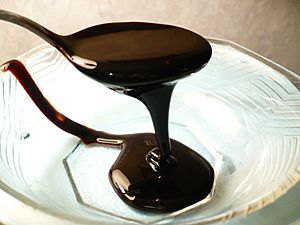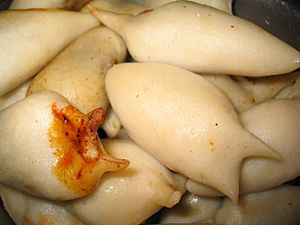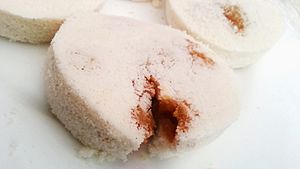Molasses facts for kids
Molasses is a thick, sweet syrup. It's a by-product made when sugar is taken out of sugarcane or sugar beets. In the United Kingdom, molasses made for people to eat is often called treacle. Molasses can look like a dark golden or even black syrup.
Molasses is also used to make rum. Sometimes, it's even used to make vodka.
Contents
What's in a Name?
The word "molasses" comes from the Portuguese word melaço. This word is related to other words for honey, like méli in Ancient Greek and mel in Latin.
Sugarcane Molasses
Molasses made from sugarcane is used a lot in baking and cooking. A long time ago, before the 1900s, it was a very common way to sweeten food in the Americas.
To make molasses from sugarcane, here's how it works:
- First, sugarcane plants are gathered and their leaves are removed.
- Next, the juice is squeezed out of the cane, usually by crushing it.
- Then, this juice is boiled. Boiling makes the water evaporate and helps sugar crystals form.
- The liquid left after the first boiling is called first syrup. This syrup has the most sugar.
- If you boil the syrup a second time and take out more sugar, you get second molasses. This kind tastes a bit bitter.
Blackstrap Molasses
After the syrup is boiled a third time, you get a very dark, thick molasses called blackstrap molasses. It has a strong, bold flavor. Most of the sugar has been taken out by this point.
Even though most sugar is gone, blackstrap molasses has good things in it! It contains important vitamins and minerals. These include calcium, magnesium, iron, and manganese. Just one tablespoon can give you a good amount of these nutrients for the day. It's also a good source of potassium. Because of these nutrients, blackstrap molasses has been sold as a dietary supplement.
Blackstrap molasses is much more bitter than other types. People sometimes use it in baking or to make ethanol (a type of alcohol). It's also used as an ingredient in cattle feed and as fertilizer for plants.
Sugar Beet Molasses
Molasses made from sugar beets is different from sugarcane molasses. The syrup left after the final sugar is taken out is called molasses. This type of molasses is about half sugar by dry weight, mostly sucrose, but it also has glucose and fructose.
Beet molasses has many salts, like calcium and potassium. It also contains other natural plant chemicals. These make it taste bad for humans, so it's mostly used for animal feed or for making yeast.
Unsulphured Molasses
You might see molasses labeled "unsulphured." In the past, some foods, including molasses, were treated with sulfur dioxide. This helped keep them fresh by stopping mold and bacteria. Sulfur dioxide also made the molasses lighter in color.
Today, most brands don't use sulfur dioxide because untreated molasses stays fresh well on its own. Also, sulfur dioxide can give an off-flavor and isn't good for you in large amounts.
Other Kinds of Molasses
In the Middle East, people make molasses from fruits like carob, grapes, dates, pomegranates, and mulberries. In Nepal, a type of molasses called chaku is used in traditional foods like yomari.
How We Use Molasses
Molasses is used in many ways:
- In dark rye breads and other whole grain breads.
- In some cookies and pies.
- In gingerbread, especially in the Americas.
- In barbecue sauces.
- In some types of beer, like stouts.
- As a main ingredient to make rum.
- To help keep jerky moist.
- To make yeast.
Images for kids
See also
 In Spanish: Melaza para niños
In Spanish: Melaza para niños






